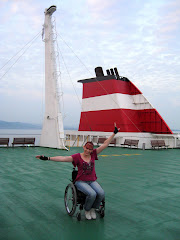Last week I
wrote about travelling alone. I wanted to continue that thought, with some
conclusions. I had five days on the
coast near Mombassa before leaving Kenya.
During those five days, I was loathe to leave the comfort of my resort
unless I had an excursion planned with my trusted taxi driver, Dennis, at the
helm.
I didn’t
want to stroll the beach, because the beach had men trying to sell souveniers
or trying to get me to take an excursion with them (snorkeling, camel ride, jet
skiing, etc.). And my resort wasn’t without pestering by staff, either. I had one waiter who informed me the third
day (I had asked him the first day about what the dinner buffet entailed) that
he had the evening off and maybe I’d like to do something with him. He asked a couple of times and I turned him
down.
Another
night, one of the chefs serving asked where I was from and when I said Canada
he asked if I could help him get to Canada.
These two guys seemed more aggressive than the fellows I chatted to
while on safari. But the most persistent
was the guide I had at Bombolulu Village.
He went through the usual questions… where did I live, am I married, how
many children, how many brothers and sisters, what kind of job do I do… and
then strongly hinted that maybe I could invite him to Canada. When I ignored that, he repeated it again and
also asked for my email address. I said
no, he wasn’t getting my email address.
Then, when he showed me the various huts, he talked about in one hut
people got naked before they had medical treatment. When he showed me the Swahili master bedroom
he demonstrated how the camel bed swayed to enhance having sex. He definitely had sex on the brain. I was relieved when I got back to the taxi
and had Dennis drive me back to the resort.
I had plenty
of time to ponder why the personal questions.
I was getting hit on multiple times a day, and this is NOT NORMAL for me! I had developed a theory, but needed it
verified. Dennis, my taxi driver, was just the guy to do it. Why Dennis? Well, beside the fact that he was friendly
and hadn’t actually hit on me, I felt I could trust him.
At some
point early in my stay, we talked about Christianity and he told me he was a
Christian. When I said I was too, it
made him very happy. Then he told me
about his church and how his life had changed since becoming a Christian. The remaining excursions I had with him, he
played Christian music videos in his car, instead of the African folk. Also, when I asked if he could take me to the
airport on Sunday he said it depended on what time, because he would be busy
all morning at church. When I said it was
late afternoon, he said he could manage that.
He suggested that I could pray in my room on Sunday since I wasn’t going
to church.
Anyway, my
point being that I thought I could get an honest answer from him. En route to the airport I mentioned how the
kitchen staff and men on the beach asked all these questions and asked him why
they did that. He verified my theory –
which was that the men are basically out to seduce western women. Their plan was to get the woman to take them
back to their home country so they can have a new life. It didn’t matter whether they were married in
Kenya, they’d still take off. There were
lots of these types of men, who were dishonest and according to Dennis, more
often than not got into trouble in their new country.
He asked if
I had noticed the number of white women on the beach with a black male
partner. I had. He said this is what the men were doing. What I don’t get is why women would go along
with it. You’re in Africa, for crying
out loud, where AIDS is still prevalent.
Why start a beach romance with some guy who might have a new partner
every week. Doesn’t sound very smart to
me!
In keeping
with this topic, here’s a billboard I took a photo of. Seemed to fit into this blog post.
I am glad to
be home, where I can walk the sea shore in peace and don’t have all the
unwanted advances. And even better, I
don’t have to barter for my purchases in the stores! I’m back in my cultural comfort zone.






















































